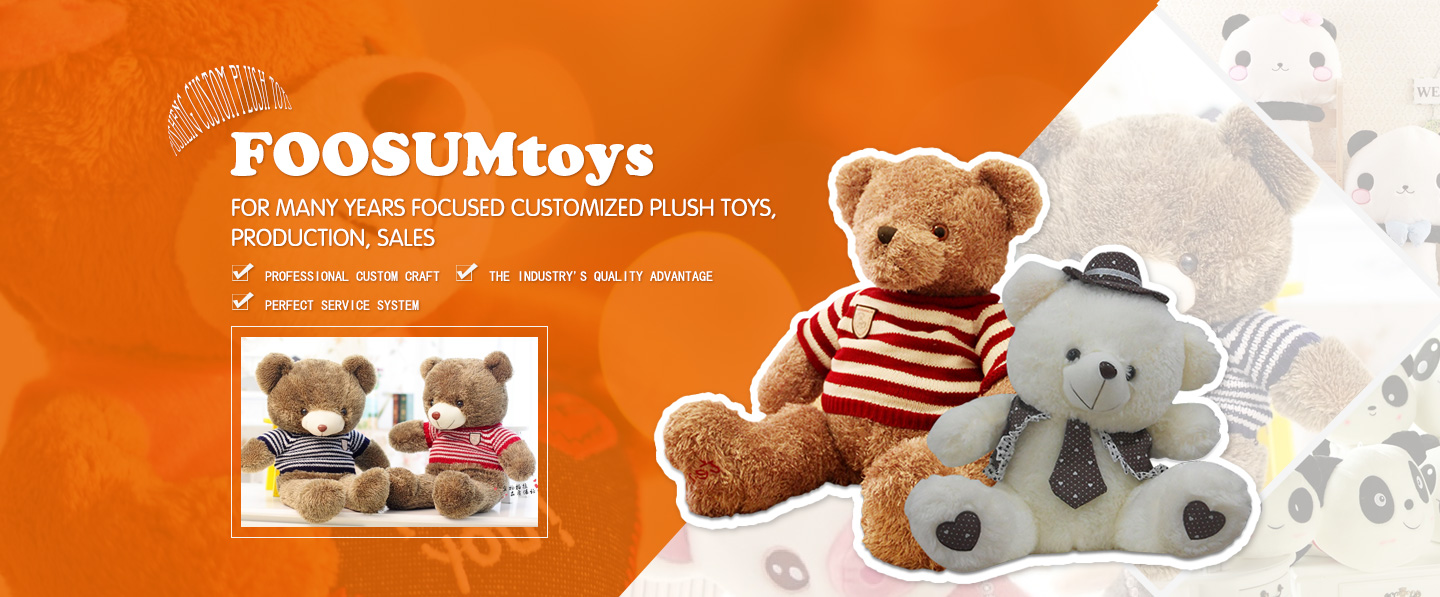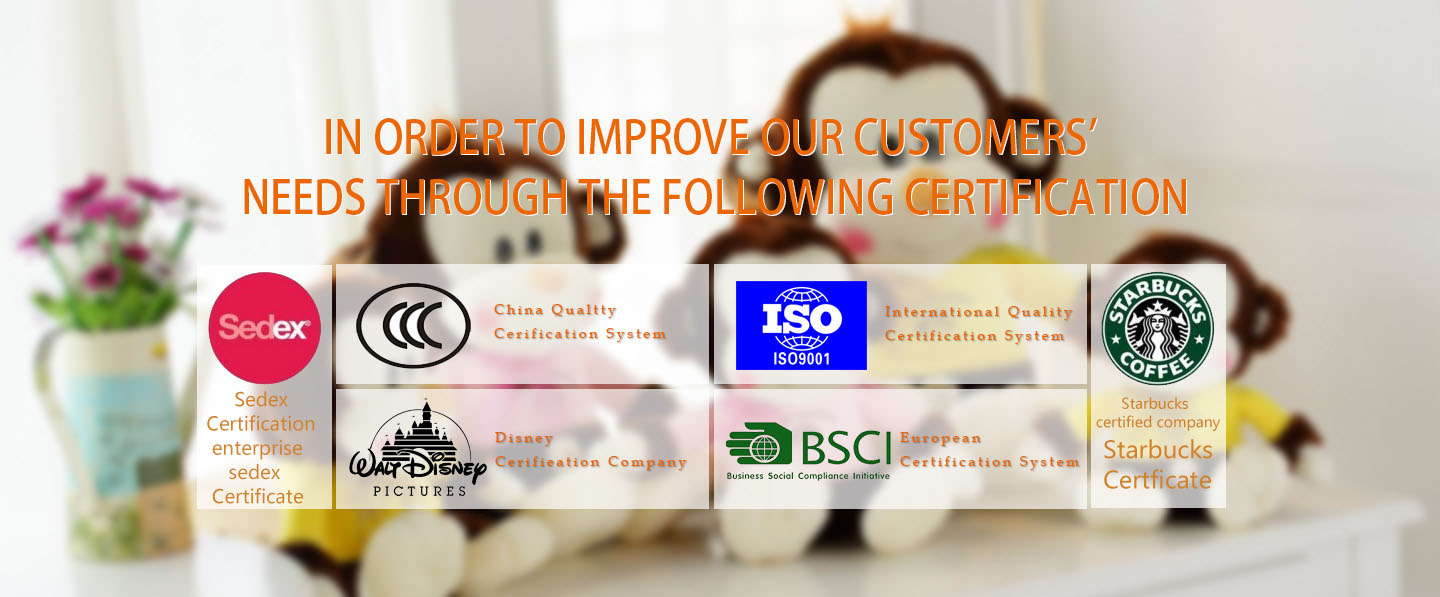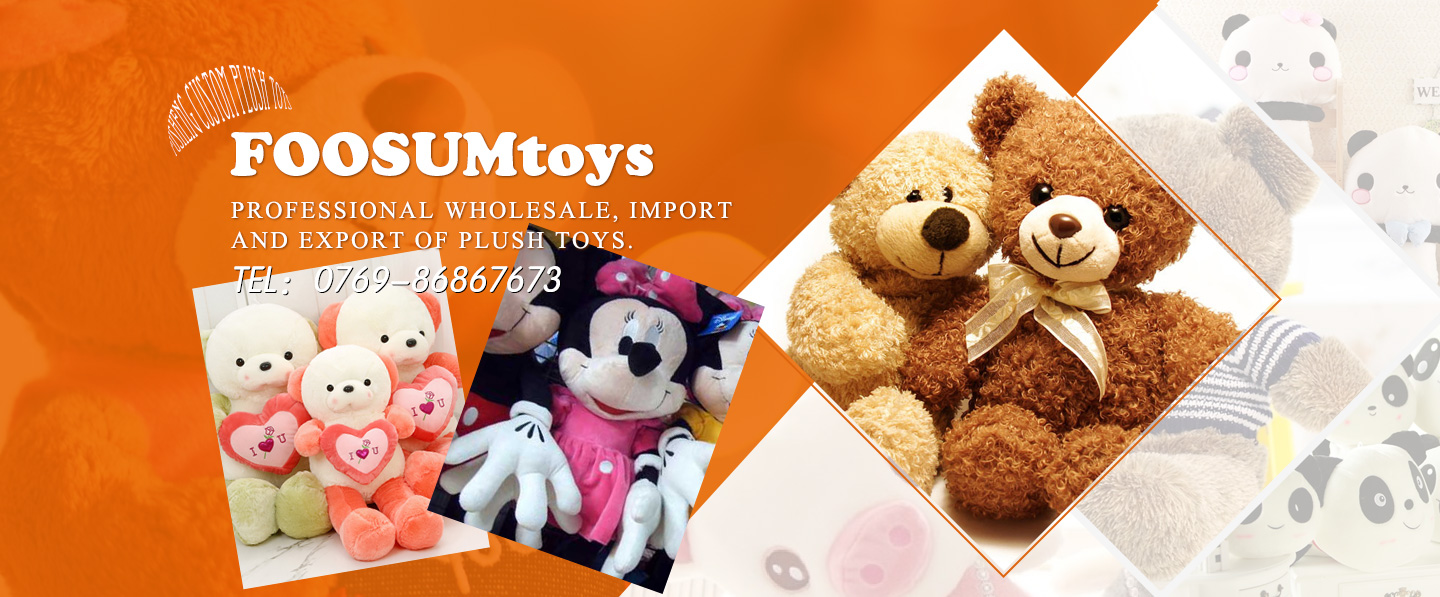Foosum Toys
Contact Us

DONGGUAN FOOSUM TOYS CO.,LTD.
Contact: Miss Tang
Mobile:18680405363
Tel:0769-86867673-861
QQ:2043995439
E-MAIL:lily.tang@foosum.com
Address: Dongguan Chashan Dasan Hengjiang Fifth Industrial Zone
A detailed overview of the basic knowledge of plush toys
release time:2021-05-28 15:00:35
1. What is a plush toy: plush toys are also called stuffed toys, which are made by cutting, sewing, decorating, filling, shaping, packaging and other raw materials such as PP cotton, plush, short plush, etc. Toys.
2. The characteristics of plush toys: plush toys have the characteristics of lifelike and cute shape, soft touch, not afraid of squeezing, convenient cleaning, strong decoration, high safety, and a wide range of applicable people. So stuffed toys are used for children
Toys, decorating houses and giving gifts as gifts are all good choices.
3. Classification of plush toys: plush toys can be divided into: stuffed toys and non-stuffed toys; velvet stuffed toys, plush stuffed toys, T/C cloth stuffed toys,
Pull plush stuffed toys.
4. Materials used for plush toys: The main materials used for plush toys are: plush, T/C cloth, knitted cloth, acrylic cotton, artificial leather, non-woven fabrics, nanoparticles, chemical fiber fleece (plush, velvet) , Plush spare parts, etc.
5. Production process of plush toys: The production process of plush toys is basically: cutting, sewing, decoration,
Filling, shaping, packaging.
6. Export standards for plush toys: In order to prevent the emergence of black cotton and plush toys containing toxic substances, the main export of plush toys currently has certain standards, which must follow the national standard, the American standard, and the European Union.
Tests based on physical standards can only be exported and sold.
Introduction of plush product knowledge (1)
1. General situation of plush toys and cloth plush toys
Simply speaking, plush toys and cloth plush toys refer to the production of various chemical fibers, pure cotton, non-woven fabrics, leather, plush, short plush and other materials through three-dimensional tailoring, filling, shaping, and packaging. Toy, one of the big toys, has the advantages of beautiful appearance, realistic shape, softness, pressure resistance, safety
Health, development of intelligence and decoration, suitable for all ages.
2. Standard
Export, National Standard, American Standard, European Community Standard
Three, classification
1. According to the current production characteristics, the products basically have fillers, so it can be said that plush toys and cloth plush toys are referred to as stuffed toys in general.
2. It can be divided into stuffed toys and non-stuffed toys according to whether it is filled.
3. Stuffed toys are divided into plush stuffed toys, velvet stuffed toys, and drawn plush stuffed toys according to their appearance.
4. According to the appearance of the toy, it can be divided into stuffed animal toys, equipped with high-intelligence electronics, movement, audio animal toys or dolls, and various holiday gift toys.
Four, production
1. Process: cutting → sewing → assembling → filling → shaping → packaging
(1) First, the design department or the customer submits the sample plate to the mold cutting workshop to make the mold and cut the material;
(2) The lathe worker sews on the machine, the main task is to sew the main body, attach the cloth label, and sew additional accessories;
(3) Install accessories such as eyes and nose;
(4) The cotton filling machine is filled with cotton;
(5) Manual stitching of the cotton filling mouth, shaping, and hanging the thread;
(6) Inspect, cut off the thread at the same time, brush to remove the lint;
(7) High-pressure air pump blowing velvet;
(8) Detect metal deposits to ensure safety;
(9) Playing tag;
(10) Packaging and delivery.
2. Materials used: plush, chemical fiber fleece (plush, velvet) acrylic cotton, combined with plastic particles, artificial leather, non-woven fabrics, toy parts, accessories.
3. Material consumption: medium toys are about 18CM-25CM, and the material consumption of stuffed toys is more complicated. The material consumption mainly depends on the number of toy varieties, the composition of several kinds of raw materials for each variety, what proportion each, the size of the toy specifications, and the raw materials Whether the width is fully utilized, whether the blanking is mechanized, etc.
4. Reasonable design, typesetting, production organization, and the use of modern equipment are the main reasons for cost reduction
Vegetarian.
Five, select
1. First clarify the needs of people in which age group, and then buy different toys according to different age groups, mainly considering safety and practicality.
2. Whether the surface cloth and velvet materials are considered to be hygienic, divided by the high and low grades of raw materials, long and short plush (special yarn, ordinary yarn), velvet, brushed TIC cloth, etc., if there is filler inside, see if it is a regular raw material ( Transform
Whether the color matching of fiber length and short silk, acrylic cotton) is reasonable.
3. Whether the fixed accessories are firm (the standard requirement is 90N force) is very angry, and whether the moving parts are too small to prevent children from accidentally entering the mouth when playing, and whether the raw materials of the same color or the same position have the same hair direction. Otherwise, the color will be different under the sun, and the hair will be in the opposite direction, which will affect the appearance.
4. Observe whether the appearance is beautiful, whether the left and right positions are symmetrical, whether the backlog is soft and fluffy, whether the stitching of each part is firm, whether the toy accessories are scratched or incomplete.
5. Check whether there are trademarks, brands, safety signs, manufacturer's communication address, etc., and whether the binding is firm.
6. Check the inner and outer packaging, whether the signs are consistent, and whether the moisture-proof performance is good. If the inner packaging is a plastic bag, and the opening size exceeds a certain range, there must be vents to prevent children from suffocating the head by mistake.
Six, maintenance
1. Keep the room clean to minimize dust, and clean the surface of the toy with clean, dry and soft tools frequently.
2. Avoid long-term sunlight and keep the inside and outside of the toy dry.
3. When cleaning, you can take necessary measures according to the size. If the size is small, you can use tape to dip the parts that are afraid of abrasion, and directly put it in the washing machine for soft washing, spin dry, hang in a cool place to dry, and intermittently pat the toy to make it The fur, the filling is fluffy and soft. For large toys, you can find the filling seam, cut the stitches, take out the special part of the filling (eyelen cotton), you can not take it (better maintain the appearance) and use tape to stick the parts that are afraid of wear. Wash the outer skin and dry it, then put the stuffing in the toy skin, shape it, and sew it together.
4. For wool/cloth or dolls equipped with high-intelligence electronics, machine cores, and speakers, the electronic components (some are not waterproof) or batteries must be taken out before cleaning to prevent water damage.
5. After the cleaned toy is dry, use a clean comb or similar tool to comb it neatly in the direction of the fur to make the fur smooth and beautiful.
Seven, advantages
As a kind of toy, it has unique advantages, beautiful appearance, realistic shape, soft hand feeling, no fear of squeezing, high safety, convenient and hygienic cleaning. Develop intelligence, strong decoration, suitable for a wide range of people, young and old
All benefits, good quality and low price.
8. Market
At present, it has a broad market, and it has great development prospects both at home and abroad, especially plush stuffed toys and Christmas gift toys. There are many bases in our country. There are Guangzhou, Zhejiang and Jiangsu regions in the south and Shandong region in the north. The major international consumer countries and regions are mainly concentrated in Europe, the United States, Japan, South Korea,
Taiwan, Hong Kong and other places. Domestic export ports are mainly concentrated in Shenzhen, Shanghai, Qingdao, etc.
Nine, toy maintenance
1. Check whether the internal organs of plush toys are clean and hygienic. Unqualified toy stuffing includes discarded plastic, fiber rope, paper scraps, and even black cotton which is banned by the state.
2. Twist the eyes, nose and mouth of the plush toy to see if it is firm. If there are small parts on the toy,
If the pulling force does not meet the national standard, it is a substandard product.
3. For good health, plush toys should be consumed and cleaned regularly.
4. Simple and easy sterilization and disinfection method, you can use a steam iron with higher power to gently reciprocate the hair on the fluff, and it also has a certain sterilization and decontamination effect.
5. The key to washing plush toys at home: For toys with few small parts, they can be hand-washed or machine-washed in warm water at 30-40 degrees Celsius. Neutral laundry detergent can be used for cleaning. For plush toys, cashmere detergent will have a better effect. better.
6. How to make the toy not easy to get dirty and prolong its lifespan. When buying toy glutinous rice, don't throw it away, whether it is a paper box or a plastic bag, in case it is used for packing dust during storage. In humid climate areas, in order to prevent toys from getting wet, a desiccant can be placed during storage. Stuffed toys should be stored as far as possible to avoid backlog to avoid deformation and damage.
Introduction of plush product knowledge (2)
Nowadays, toys are not only children's favorites. Nowadays, more and more adults are obsessed with toys. They play with toys for a variety of reasons, some are out of their own hobbies, some are out of work pressure,
Play with toys as a leisure way to relax; some people make up for the regret of not having toys when they were young.
In European and American countries, as well as Japan, South Korea, Singapore, Hong Kong, and Taiwan, toys have become a part of people's cultural life. A beloved toy can be played from birth to old age. In China, the trend of adults playing with toys is increasingly taking shape, but many adults still dare not take action due to "face". In fact, toys do not necessarily belong to children only, and adults do not need any reason to like toys. It is a fairy tale for adults, and the beautiful baby store is a fairy tale world for adults. Our products are mainly plush toys. Here are some knowledge about plush toys:
1. The status quo of plush toys
Plush toys seem to have a natural ability, and people can't help their childlike innocence when they see them, and fly into this soft and lovely world "in spite of their image". However, perhaps children simply like the appearance of plush toys, but adults prefer practical plush toys.
Nowadays, animal plush toys are gradually merging with daily life, animal-shaped pillows, cushions, handbags,.... They can be placed in every corner of the home, like toys, but also real daily necessities. Adults can have close contact with plush toys at home at any time.
There are also many star toys in the toy family. The most familiar are the smiling Hello Kitty, the alternative Garfield, the funny Snoopy, the noble Barbie, and other cartoon stars. These cartoon stars are also affected by the "market". Sometimes the hits of movies or animations will make the toy market a craze for toy stars.
Second, the composition of plush toys
Recognition of toy fabrics (commonly used):
1. Plush cloth:
A, A yarn (also called ordinary yarn, BOA material), divided into:
Glossy yarn: Normally, it is shiny, and the yin and yang sides can be distinguished by different hair directions under the light. Matt
Yarn: It is matte, basically without yin and yang.
B, V yarn (also called special yarn, T-590, Vonnel) has Even Cut and long and short wool (Uneven
cut), the hair length is in the range of 4-20mm, which is a mid-range material;
C. Hipile (Shanghai style, plush): The hair length is within the range of 20-120mm, and the range of 20-45mm is fine.
For any hair length, only 65mm and 120 (110) mm above 45mm are long and short hairs.
D. Other:
1. Curly wool (rolling bundle hair): ①Tumbling boa, A yarn curling: mostly granular wool, lamb wool, or hair roots are bundled, and the top is rolled up. Usually used to make more classical toys, the hair length can be up to 15mm; the price is much cheaper than the Shanghai style curly hair. ②Tumbling H.P, Shanghai style curly hair: usually the hair is longer and curly
The effect is loose and there are many styles to choose from;
2. Super soft material: It has been used, the material is very soft; note that the price of the original yarn is different.
3. There is also D.D.F: It is a kind of H.P., hard straight, high-grade material, usually mixed colors.
E. Plush printing materials include: 1. printing; 2. jacquard; 3. tip-dyed: (like mixed wool
Glasses open book);
4. Variety;
5. Two tone and so on.
Whether the hair surface effect is dense, upright, supple, whether there are abnormal indentations, wavy lines, messy hair direction, etc.
Often phenomenon.
2. Velboa (Velboa) wool surface softness, generally the quality of the fallen wool is poor.
3. Velour (velour): similar to shearing cloth, but the hair length is about 1.5-2mm, and the elasticity is larger than that of shearing cloth; there is no wool direction.
Fourth, the side lun cloth (Nylex, Tricot): It is divided into ordinary side lun cloth (100% Polyster) and nylon side lun cloth (Nylon), and the common type is usually used. It is easy to make, cut pieces and silkscreen, and embroider. In the case of cut pieces and silkscreen, the hair length of the fetching hair must be controlled not to grow (usually no more than 1mm), otherwise the silk printing will be difficult, the color will not penetrate easily, and the color will fade easily.
5. T/C cloth: (The composition is 65% Polyster, 35% Cotton) There are three types:
110X76: thicker, used in printed fabrics or products with higher requirements; (higher density, not easy to spread) 96X72: second; the density is thinner. 88X64: Again. Due to the loose organization, usually orders are required
Seek the medium to become a light paste, so as to avoid the seams are easy to loose edges, causing bursts.
2) and 3) are usually used for interlining. When using, choose according to the grade and purpose of the product.
6. Cotton cloth (100% Cotton): It is used to make higher-grade printed cloth, which is thicker than T/C cloth.
7. Felt: Pay attention to the thickness and flexibility. It is divided into ordinary polyester and acrylic. We usually use ordinary polyester, which is harder and has a thickness of about 1.5mm. The acrylic is very soft, and the tissue is loose and easy to rot. , Often used in gifts, less used in toys.
8. Polar fleece; divided into single-sided fleece and double-sided fleece. It has a soft hand feeling but greater elasticity.
Nine, PU leather: It is a kind of Polyester, not leather. Note that the thickness of the fabric will vary depending on the base fabric.
※Note: PVC materials cannot be used in all toys now, because PVC contains excessive toxic and fatal elements, so please pay attention to the material when purchasing. As for packaging materials, some customers accept PVC
Some materials are not accepted, so be very careful.
10. Twill (Heavier T/C): Cotton or T/C: thicker, the grain is clearly visible.
11. Zheshi cloth: the texture is measured by the count; it should be selected according to the grade and purpose of the product.
12. Knitted fabric: According to the gram weight, the quality is divided into cotton or T/C. The fabric has greater elasticity.
13. Electronic cashmere: thinner and brighter, but the wool surface is not soft enough;
14. Velvet: There are several grades. The difference from electronic velvet is that it is softer and relatively expensive.
15. Flocking Material: It is divided into single-sided and double-sided. If the base fabric is different, the thickness and hardness of single-sided flocking are different, and the price is also different.
16. Satin: Usually it is not easy to sew, it is too soft and easy to run yarn;
17. Nylon cloth: Lining cloth: 170T, a kind of nylon cloth. It is very thin and cheap. You can consider making the inner bag lining: ordinary nylon cloth: 190T: thick nylon cloth: 210T: Oxford cloth: more than 420T.
18. Washable cloth and wrinkle cloth (Nylon Taffeta): The cloth surface has wrinkles, because it can be washed with water, some products will be used, but it is not easy to sew).
19. Terry cloth: Cotton: The loops are relatively high and look rough. When used on toys, use a thick and dense base cloth to make it difficult for the cotton to escape. T/C category: fine and smooth loops




